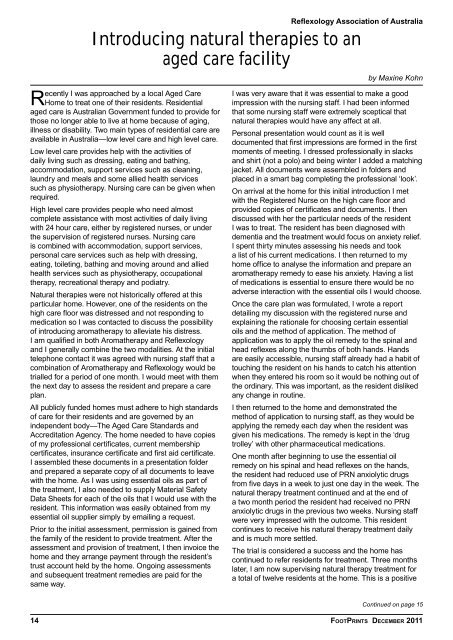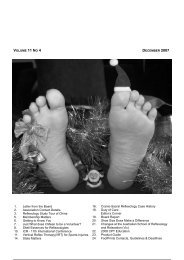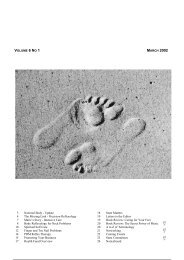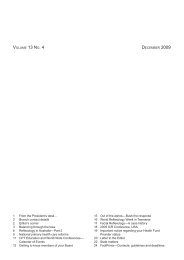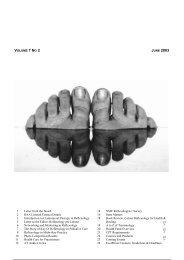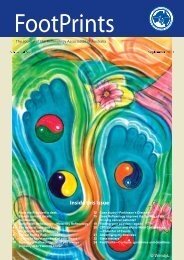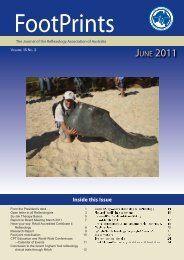FootPrints_Dec_11_Vol_15_No4.pdf 3266KB Apr 26 2013 03:57:58 ...
FootPrints_Dec_11_Vol_15_No4.pdf 3266KB Apr 26 2013 03:57:58 ...
FootPrints_Dec_11_Vol_15_No4.pdf 3266KB Apr 26 2013 03:57:58 ...
Create successful ePaper yourself
Turn your PDF publications into a flip-book with our unique Google optimized e-Paper software.
Reflexology Association of Australia<br />
Introducing natural therapies to an<br />
aged care facility<br />
Recently I was approached by a local Aged Care<br />
Home to treat one of their residents. Residential<br />
aged care is Australian Government funded to provide for<br />
those no longer able to live at home because of aging,<br />
illness or disability. Two main types of residential care are<br />
available in Australia—low level care and high level care.<br />
Low level care provides help with the activities of<br />
daily living such as dressing, eating and bathing,<br />
accommodation, support services such as cleaning,<br />
laundry and meals and some allied health services<br />
such as physiotherapy. Nursing care can be given when<br />
required.<br />
High level care provides people who need almost<br />
complete assistance with most activities of daily living<br />
with 24 hour care, either by registered nurses, or under<br />
the supervision of registered nurses. Nursing care<br />
is combined with accommodation, support services,<br />
personal care services such as help with dressing,<br />
eating, toileting, bathing and moving around and allied<br />
health services such as physiotherapy, occupational<br />
therapy, recreational therapy and podiatry.<br />
Natural therapies were not historically offered at this<br />
particular home. However, one of the residents on the<br />
high care floor was distressed and not responding to<br />
medication so I was contacted to discuss the possibility<br />
of introducing aromatherapy to alleviate his distress.<br />
I am qualified in both Aromatherapy and Reflexology<br />
and I generally combine the two modalities. At the initial<br />
telephone contact it was agreed with nursing staff that a<br />
combination of Aromatherapy and Reflexology would be<br />
trialled for a period of one month. I would meet with them<br />
the next day to assess the resident and prepare a care<br />
plan.<br />
All publicly funded homes must adhere to high standards<br />
of care for their residents and are governed by an<br />
independent body—The Aged Care Standards and<br />
Accreditation Agency. The home needed to have copies<br />
of my professional certificates, current membership<br />
certificates, insurance certificate and first aid certificate.<br />
I assembled these documents in a presentation folder<br />
and prepared a separate copy of all documents to leave<br />
with the home. As I was using essential oils as part of<br />
the treatment, I also needed to supply Material Safety<br />
Data Sheets for each of the oils that I would use with the<br />
resident. This information was easily obtained from my<br />
essential oil supplier simply by emailing a request.<br />
Prior to the initial assessment, permission is gained from<br />
the family of the resident to provide treatment. After the<br />
assessment and provision of treatment, I then invoice the<br />
home and they arrange payment through the resident’s<br />
trust account held by the home. Ongoing assessments<br />
and subsequent treatment remedies are paid for the<br />
same way.<br />
by Maxine Kohn<br />
I was very aware that it was essential to make a good<br />
impression with the nursing staff. I had been informed<br />
that some nursing staff were extremely sceptical that<br />
natural therapies would have any affect at all.<br />
Personal presentation would count as it is well<br />
documented that first impressions are formed in the first<br />
moments of meeting. I dressed professionally in slacks<br />
and shirt (not a polo) and being winter I added a matching<br />
jacket. All documents were assembled in folders and<br />
placed in a smart bag completing the professional ‘look’.<br />
On arrival at the home for this initial introduction I met<br />
with the Registered Nurse on the high care floor and<br />
provided copies of certificates and documents. I then<br />
discussed with her the particular needs of the resident<br />
I was to treat. The resident has been diagnosed with<br />
dementia and the treatment would focus on anxiety relief.<br />
I spent thirty minutes assessing his needs and took<br />
a list of his current medications. I then returned to my<br />
home office to analyse the information and prepare an<br />
aromatherapy remedy to ease his anxiety. Having a list<br />
of medications is essential to ensure there would be no<br />
adverse interaction with the essential oils I would choose.<br />
Once the care plan was formulated, I wrote a report<br />
detailing my discussion with the registered nurse and<br />
explaining the rationale for choosing certain essential<br />
oils and the method of application. The method of<br />
application was to apply the oil remedy to the spinal and<br />
head reflexes along the thumbs of both hands. Hands<br />
are easily accessible, nursing staff already had a habit of<br />
touching the resident on his hands to catch his attention<br />
when they entered his room so it would be nothing out of<br />
the ordinary. This was important, as the resident disliked<br />
any change in routine.<br />
I then returned to the home and demonstrated the<br />
method of application to nursing staff, as they would be<br />
applying the remedy each day when the resident was<br />
given his medications. The remedy is kept in the ‘drug<br />
trolley’ with other pharmaceutical medications.<br />
One month after beginning to use the essential oil<br />
remedy on his spinal and head reflexes on the hands,<br />
the resident had reduced use of PRN anxiolytic drugs<br />
from five days in a week to just one day in the week. The<br />
natural therapy treatment continued and at the end of<br />
a two month period the resident had received no PRN<br />
anxiolytic drugs in the previous two weeks. Nursing staff<br />
were very impressed with the outcome. This resident<br />
continues to receive his natural therapy treatment daily<br />
and is much more settled.<br />
The trial is considered a success and the home has<br />
continued to refer residents for treatment. Three months<br />
later, I am now supervising natural therapy treatment for<br />
a total of twelve residents at the home. This is a positive<br />
Continued on page <strong>15</strong><br />
14 FOOTPRINTS DECEMBER 20<strong>11</strong>


